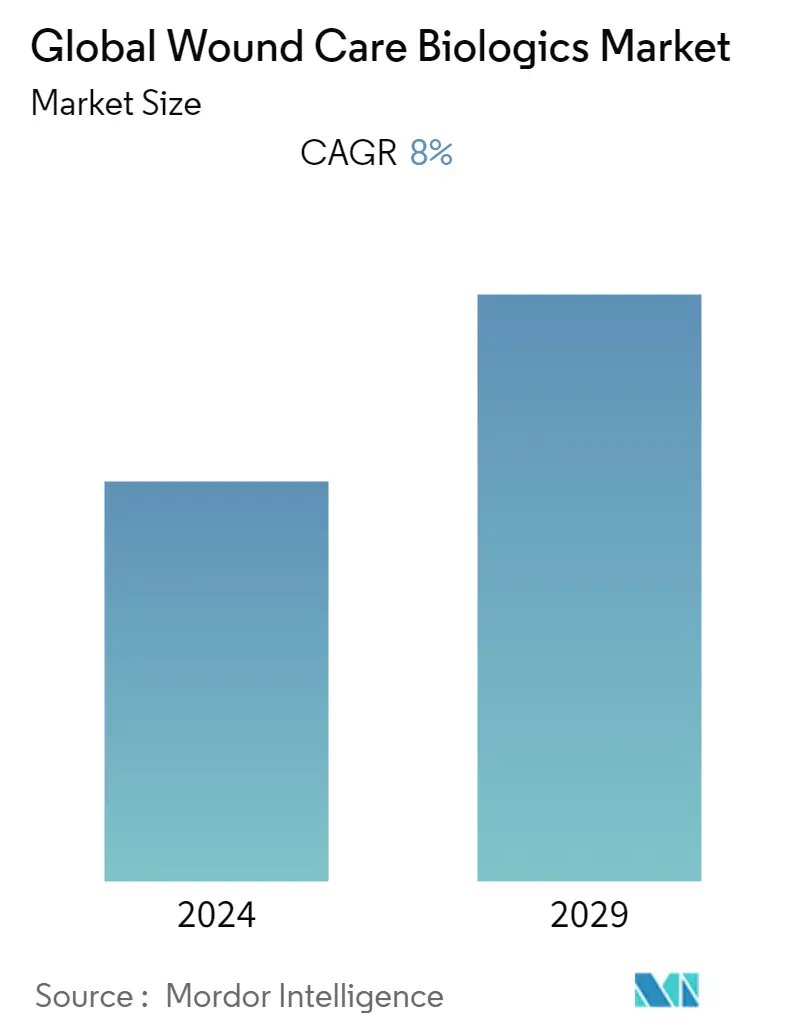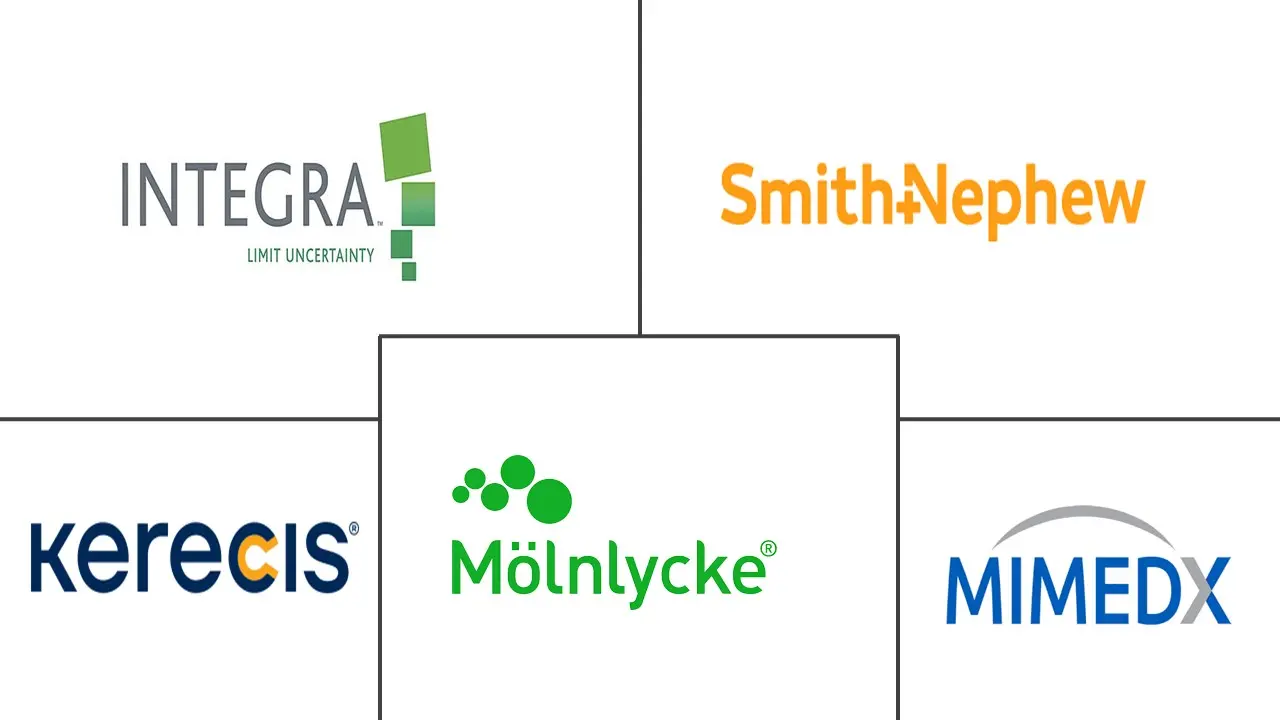Market Size of Global Wound Care Biologics Industry

| Study Period | 2019 - 2029 |
| Base Year For Estimation | 2023 |
| CAGR | 8.00 % |
| Fastest Growing Market | Asia-Pacific |
| Largest Market | North America |
| Market Concentration | Low |
Major Players
*Disclaimer: Major Players sorted in no particular order |
Wound Care Biologics Market Analysis
The Wound Care Biologics market is projected to register a CAGR of 8% during the forecast period (2022 - 2027).
The COVID-19 pandemic caused serious issues with the provision of wound care. Due to several comorbidities, wound patients are more likely to experience COVID-19's most serious effects. As a result, fewer hospital admissions and reduced diagnoses affect the biologics used in wound care. Even during the COVID-19 crisis, managing chronic wounds is important. According to the study titled 'COVID-19: Issues related to wound care and telehealth management' by Alisha Oropallo, in June 2022, to lower their risk of contracting SARS-CoV-2, patients must make fewer trips to clinics, home health nursing services, or wound care facilities. After a thorough investigation, 115 clinics contained 39,750 wounds involving 17,849 patients. Because of this, the market cannot grow due to a decline in patient visits and wound complaints. Furthermore, as per the study article "The risk of pressure ulcers in a prone COVID population" published in 2021, the study stated that around 88.7% developed anterior pressure ulcers. As per the same source mentioned above the risk of pressure, and ulcers is high in the COVID population. Thus, during COVID-19 the wound care biologics market significantly impacted.
Wound care biologics is gaining popularity for the treatment of wounds and burn injuries. Factors, such as the growing burden of burn injuries, the increasing burden of diabetic foot ulcers and pressure ulcers, and government initiatives regarding wound care treatment are driving the growth of the wound care biologics market.
The wound care biologics market is expected to gain significant traction, with rising in the global prevalence of diabetes, as diabetic patients are prone to developing diabetic ulcers. For instance, the incidence of diabetes among all ages is increasing, mainly due to obesity, unhealthy diet, and physical inactivity. According to the study titled "Diabetic Foot Ulcer" published in the National Library of Medicine in May 2022, worldwide, there are 9.1 to 26.1 million diabetic foot ulcers every year. Approximately 15% to 25% of people with diabetes mellitus have experienced a diabetic foot ulcer at some point in their lives. The incidence of diabetic foot ulcers is destined to rise as the number of people newly diagnosed with diabetes rises each year. As a result, it is predicted that throughout the forecast period, demand for wound care biologics will increase, supporting market expansion. Moreover, burns not only have a high economic impact but also have disastrous effects on the victim's skin. Therefore, the availability of superior quality synthetic substitutes and their growing demand in the treatment of burns have proven beneficial for the industry's growth. According to the study titled "Socio-demographic features and quality of life post burn injury' published in the Journal of Family Medicine and Primary Care in March 2022, there are 6 to 7 million burn injury victims worldwide and in India. One million of them are of a moderate-to-severe grade and require long-term rehabilitation services in addition to excellent medical care. 1.4 lakh near-fatal cases of burn-related accidents occur each year in Delhi alone. Within the last five years, there has been a 10-fold increase in outpatient care and a four- to five-fold increase in hospital admissions due to the increase in burn cases and patients seeking medical attention.
Moreover, market players are frequently launching new products and adopting various growth strategies in their respective segments, which is likely to drive market growth. For Instance, in October 2021, RedDress entered into a partnership with MediGroup to deliver its innovative wound care solution, ActiGraftsystem to MediGroup'smembers. ActiGraftaims to deliver an affordable and efficacious wound solution to MediGroup'smembers to help improve the health and lives of patients living with chronic, non-healing wounds including diabetic foot ulcers, pressure injuries, venous ulcers, traumatic wounds, and post-surgical wounds. Therefore, the growing focus on the development of better treatment options, along with the huge burden of diseases, is expected to drive the wound care biologics market. However, the high treatment cost is expected to restrain the growth of the global market in the forecast period.
Wound Care Biologics Industry Segmentation
As per the scope of the report, wound care biologics refer to products that are used for controlling and healing infections. Wound healing is a complex process involving inflammation, accumulation of tissue, deposition of collagen, and formation of epithelial cell layers. The Wound Care Biologics Market is Segmented by Product (Biological Skin Substitutes and Topical Agents), Wound Type (Ulcers, Surgical and Traumatic Wounds, and Burns), End-User (Hospitals/Clinics, Ambulatory Surgical Centers, and Other End Users), and Geography (North America, Europe, Asia-Pacific, Middle East & Africa, and South America). The market report also covers the estimated market sizes and trends for 17 different countries across major regions, globally. The report offers the value (in USD million) for the above segments.
| By Product | |
| Biological Skin Substitutes | |
| Topical Agents |
| By Wound Type | ||||||
| ||||||
| Surgical and Traumatic Wounds | ||||||
| Burns |
| End User | |
| Hospitals/Clinics | |
| Ambulatory Surgical Centers | |
| Other End Users |
| Geography | ||||||||
| ||||||||
| ||||||||
| ||||||||
| ||||||||
|
Global Wound Care Biologics Market Size Summary
The wound care biologics market is experiencing significant growth, driven by the increasing prevalence of chronic wounds such as diabetic foot ulcers and pressure ulcers, alongside a rising incidence of burn injuries. The market's expansion is supported by government initiatives and advancements in treatment options, including the development of superior quality synthetic substitutes. The demand for wound care biologics is further bolstered by the growing global prevalence of diabetes, which predisposes patients to diabetic ulcers. Despite the challenges posed by the COVID-19 pandemic, which impacted patient visits and wound care provision, the market is poised for growth due to the ongoing need for effective wound management solutions.
North America is expected to lead the wound care biologics market, attributed to its high diabetic population and increasing burn injury cases. The region's market growth is fueled by the rising incidence of lifestyle disorders that lead to chronic wounds. The competitive landscape is marked by the presence of key players such as Integra LifeSciences, Mölnlycke Health Care, and Smith & Nephew, who are actively launching new products and forming strategic partnerships to enhance their market offerings. The introduction of innovative products and the adoption of advanced technologies are anticipated to further drive market growth, with a focus on improving patient outcomes and addressing the substantial burden of chronic wounds.
Global Wound Care Biologics Market Size - Table of Contents
-
1. MARKET DYNAMICS
-
1.1 Market Overview
-
1.2 Market Drivers
-
1.2.1 Growing Burden of Burn Injuries and Road Accidents
-
1.2.2 Government Initiatives Regarding Wound Care Treatment
-
-
1.3 Market Restraints
-
1.3.1 High Treatment Cost
-
1.3.2 Stringent Regulatory Guidelines and Challenges Faced by the Manufacturers
-
-
1.4 Porter's Five Forces Analysis
-
1.4.1 Threat of New Entrants
-
1.4.2 Bargaining Power of Buyers/Consumers
-
1.4.3 Bargaining Power of Suppliers
-
1.4.4 Threat of Substitute Products
-
1.4.5 Intensity of Competitive Rivalry
-
-
-
2. MARKET SEGMENTATION (Market Size by Value - USD Million)
-
2.1 By Product
-
2.1.1 Biological Skin Substitutes
-
2.1.2 Topical Agents
-
-
2.2 By Wound Type
-
2.2.1 Ulcers
-
2.2.1.1 Diabetic Foot Ulcers
-
2.2.1.2 Venous Ulcers
-
2.2.1.3 Pressure Ulcers
-
2.2.1.4 Other Ulcers
-
-
2.2.2 Surgical and Traumatic Wounds
-
2.2.3 Burns
-
-
2.3 End User
-
2.3.1 Hospitals/Clinics
-
2.3.2 Ambulatory Surgical Centers
-
2.3.3 Other End Users
-
-
2.4 Geography
-
2.4.1 North America
-
2.4.1.1 United States
-
2.4.1.2 Canada
-
2.4.1.3 Mexico
-
-
2.4.2 Europe
-
2.4.2.1 Germany
-
2.4.2.2 United Kingdom
-
2.4.2.3 France
-
2.4.2.4 Italy
-
2.4.2.5 Spain
-
2.4.2.6 Rest of Europe
-
-
2.4.3 Asia-Pacific
-
2.4.3.1 China
-
2.4.3.2 Japan
-
2.4.3.3 India
-
2.4.3.4 Australia
-
2.4.3.5 South Korea
-
2.4.3.6 Rest of Asia-Pacific
-
-
2.4.4 Middle-East and Africa
-
2.4.4.1 GCC
-
2.4.4.2 South Africa
-
2.4.4.3 Rest of Middle-East and Africa
-
-
2.4.5 South America
-
2.4.5.1 Brazil
-
2.4.5.2 Argentina
-
2.4.5.3 Rest of South America
-
-
-
Global Wound Care Biologics Market Size FAQs
What is the current Global Wound Care Biologics Market size?
The Global Wound Care Biologics Market is projected to register a CAGR of 8% during the forecast period (2024-2029)
Who are the key players in Global Wound Care Biologics Market?
Integra LifeSciences Corporation, Mölnlycke Health Care, Smith & Nephew plc, Kerecis and MiMedx Inc. are the major companies operating in the Global Wound Care Biologics Market.

